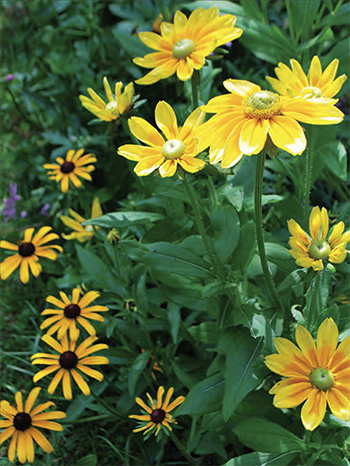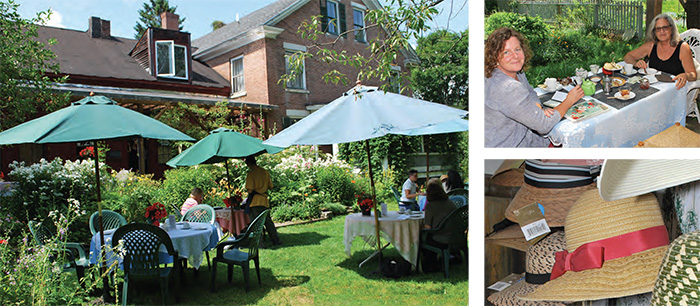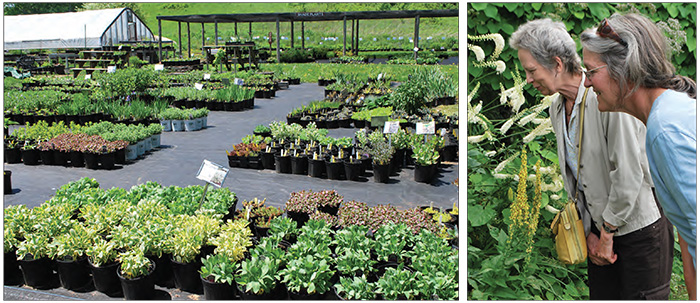| Perennial Pleasures: A Garden of Delights in East Hardwick | |
| by Kate Mueller | |
Judith and Rachel Kane proprietors of Perennial Pleasures are surrounded by photos of some of the sensational phlox that are grown on the property. Photos: Jan Doerler
|
|
Would you believe that an English teahouse, serving afternoon tea with scones on fine bone china, set amid three acres of perennial gardens, along with a greenhouse incubating rare heirloom botanicals, is located in the Northeast Kingdom? I had not heard of Perennial Pleasures until a month ago (and I am not unfamiliar with the Northeast Kingdom, having lived there as a teenager and spent much time there since), but the nursery has, in fact, been in continuous operation since 1980, when Rachel started the business at the family homestead: a beautiful 20-acre piece of property with a 1840s brick house, where Judith still lives. A Love of Historical Landscapes The family moved to the brick house in 1970, from Westchester County, NY, when Rachel, the middle child of five (she has four brothers), was 12 years old. The reason for the move: Judith went to visit a friend in Greensboro and, as she put it, “I was snowed in. It was the big storm of 1970—102 inches fell. I couldn’t get out and decided to stay!”—and, one gathers, convinced her family to join her in the Northeast Kingdom. Massachusetts is the original home of the Kane family, where Rachel and her brothers were born and where her father, Thomas Kane, earned his master’s degree in landscape architecture at the University of Massachusetts. Throughout his career, Kane advocated for the importance of landscape preservation. “It was important to him to document and demonstrate the value of cultural landscapes,” said Rachel, noting that when it comes to historic preservation, people usually think only about preserving buildings, not the grounds. Kane helped found the Alliance for Historic Landscape Preservation in 1978, which, according to the preservation’s website, is dedicated to “the preservation and conservation of historic landscapes in all their variety, from formal gardens and public parks to rural expanses.” His work in landscape preservation earned him the Conservation Service Award from the Secretary of the Interior in 1988 for “outstanding leadership in the conservation and preservation of historic and scenic landscapes.” Rachel’s father’s aesthetic and botanical influence (sadly, he died in 1995) is clearly evident. One of Rachel’s brothers became a landscape architect and another is an architect. Rachel earned two degrees at the University of Vermont: a BA in art history and a BS in plant and soil science. She noted that many of her art history papers “involved plants somehow, like botanical illustrations or landscape paintings.”
|
|
Rescuing Heirlooms Rachel started the nursery with the desire to find and cultivate rare heirloom plants, with her specialty being ornamentals. I asked her where and how she manages to locate these rare heirloom varieties. “I have rescued some plants from old gardens,” she said. “Old farmhouses may have varieties that were planted a hundred years ago: that’s where you can find these antique varieties.” She also researches plants, looks through the catalogues of other nurseries, and visits historic gardens. “I like to keep these plants available and admired,” Rachel added. One of the services that Rachel offers is garden consultations. She will come to your house and help you lay out a garden, suggest plantings, and identify plants that have come with your house. Barring a house call, she’s also willing to work with photos and notes. “I’m not a trained garden designer,” she said, “but I have an understanding historically of how gardens were organized around a household, and I can help with re-creating historic or period gardens.” |
Photo: Jan Doerler |
Aside from helping private homeowners with their gardens and yards, Rachel has been a consultant for a number of historic houses or museums, who enlist her to help them restore their gardens or grounds by identifying and locating heirloom plants. Among the historic places that she has assisted are Arlington House in Arlington, VA; Stratford Hall Plantation in Stratford, VA; Fort Ticonderoga, NY; and Alice Longfellow Garden in Cambridge, MA.
|
|
 Photo: Jan Doerler |
Tea Garden and Gift Shop In 1986, Judith—a native of London; she met her husband there at a corner café in the early ’50s—started the teahouse and gift shop. Both are housed in a wood-framed addition attached to the back of the brick house. On a recent Sunday I drove out to Perennial Pleasures with my partner, Keith, to see the nursery and experience the teahouse. It was delightful late May weather: warm but not hot, with a soft cornflower blue sky. The nursery was not difficult to find: strategically placed signs quickly directed us to the entrance at 63 Brickhouse Road, off Route 16, just outside the village. The teahouse is not immediately apparent. You must walk through the gift shop to reach the two seating areas: indoors in a small greenhouse or outdoors, through a macramé curtain, to a long, narrow verandah, partly sheltered by an attached pergola. We chose outdoors and sat down in white wicker chairs next to a bed of blue forget-me-nots with a view of a bright green lawn, a statue lurking on the edge. Our table, with a lace cloth, was laid with delicate white cups and saucers made in Czech (other floral-decorated chinaware was from England, of course), and gold-handled flatware. The recently shed petals of a nearby apple tree littered the flagstones and clung to cobwebs. Spring birds twittered and a soft breeze moved an unseen cowbell, causing the occasional distant clang. We settled in with contented sighs—ah, a welcome respite for us both. |
When we were there, the teahouse had just opened, and the menu was limited to either a petite or full English cream tea, which consists of tea (obviously) with a scone or two and delicate cucumber-herb sandwiches cut into triangles. Pots of whipped cream and strawberry jam are served on the side. A couple of desserts (lemon poppy-seed cake for one, which I was tempted to order but was too filled up on scone—next time) and other beverages, such as lemonade, are also available. The tea list is extensive and includes herbal, green, and black teas. Among the black teas, there are a number of recognizable sorts, such as English Breakfast and Earl Grey, but also several exotic varieties. I chose a Chinese tea called Rose Congou, which came to me in a multicolored striped pot. It indeed had a distinct rose aroma and flavor and made me an instant convert. Keith chose a robust Russian tea, served in a brown clay teapot. When the teahouse is in the full swing of the season, the a la carte menu expands to include more desserts and also savory dishes such as mushroom-walnut paté and tomato and smoked Edam tart. The small gift shop is packed with an eclectic bunch of stuff. A variety of straw hats, tea supplies (teapots, tea cups, tea cozies), clothing, jewelry, scarves, locally made pottery, and some toiletries, among them scented soaps—sandalwood, frankincense, lemon. What struck me was the color: the clothing included loose tops and jackets all in bright colors, along with batik cloth, shimmery gold and orange scarves from India, and green and blue necklaces made from tagua nuts, which I first mistook for polished stones. The white endosperm of these nuts, also known as vegetable ivory because it resembles elephant ivory, dyes easily and can be polished to a high sheen. Judith, who is frequently womaning the cash register, is herself a colorful statement: a cheerful forthright woman with short white hair, on the day of our visit she wore an eye-catching long turquoise-blue jacket and loose, gaily printed pants. Judith loves color and is an oil painter and teaches art to a few locals. She has also designed clothing. “I used to be a designer and had a whole line of children’s clothing. I’ve made quilts and clothing and done a bit of dyeing and batiking,” she said. In years past, Judith made much of the clothing, scarves, and tea cozies for sale at the shop but does less sewing these days. She daily bakes the delicious flaky scones and makes the strawberry jam.
|
|
Rachel conducts her informative and fun garden tours on Sundays starting at noon. Photos: Jan Doerler |
|
Wandering the Grounds We had hoped for a garden tour, but on the day of our visit, the flowers were yet to bloom—other than those forget-me-nots, some lingering apple blossoms and tulips, myrtle with purple blooms, and a few other ground flowers. So, no tour for us—but garden tours will commence in mid-June. Every Sunday at noon, Rachel leads the 45-minute tour, free and open to the public. Despite the lack of future flowers, strolling the grounds was still pleasurable. Just outside the gift shop, we found garden statues and furniture for sale: benches, Grecianesque columns laid on their sides, stone faces gazing skyward, and statuary, among them St. Fiacre, patron saint of the garden (and also, apparently, venereal disease sufferers), standing piously in monkish robes, a shovel by his side. We walked past the statuary to a gazebo and peered in (a couple of chairs and an oversized checkerboard inside), then found a path past a rustic-looking arbor draped with vines and encountered an intriguing small house with a sod roof and lettering across the front in Swedish: “Välkommen till Stugan au Rachel” (welcome to Rachel’s cottage). As it turns out, Rachel’s paternal grandmother was Swedish. Her father, neglecting to fulfill a promise to build her a playhouse when she was a child, finally built the stuga for her after she was grown. Further on we encountered various beds in the making, both display gardens and propagation areas. We found a peaceful shady area bound by a split-rail fence and hedges, with meandering stone pathways and artfully placed standing stones, which turned out to be an herb garden. According to the website, there are also island heather beds and a primrose garden. A passageway in the hedge led us to the greenhouse and a vast spread of various potted plants outside, waiting for new homes. On that luscious Sunday, the nursery was humming with activity, as folks pulled into the gravel lot and got out to wander among the many pots, selecting plants for their gardens. Maintaining all this is clearly a lot of work, and Rachel hires two to three gardeners during the season to assist her. In the greenhouse, I found familiar flowers (petunia, impatiens, cosmos) and the less familiar (calibrachoa or million bells, nicotiana, monkey flower). Altogether the nursery has over a 1,000 plant varieties, and new ones are added every year. There are plenty of perennials, but also biennials and annuals. For sale are flowering shrubs (for example, lilac, mock-orange), vines (morning glory, climbing snapdragon, plus many others), and a variety of culinary and medicinal herbs, which include the common (marjoram, basil) and the rare (spilanthes, lovage). The field-grown plants are grown organically, without chemical pesticides; fertilizer, however, is used in the greenhouse, so they are not certified organic. The nursery publishes an extensive catalog that helpfully organizes the plants in several ways: by broad categories (perennials, herbs, shrubs, vines) and by light exposure and other considerations (bee and butterfly favorites, native plants, groundcovers), along with an index.
|
|
|
|
Lots of Phlox Arguably the outstanding feature of Perennial Pleasures Nursery is Rachel’s extensive phlox collection. She has 137 cultivars and counting and believes the nursery may have the largest—or at least one of the largest—collections of phlox in the United States. Why the fascination with phlox? She said that she grew to admire them as beautiful and resilient plants: “They are very hardy. They grow well in Vermont—they’re native to North America. They’re fragrant. They were the most popular perennial at the turn of the [twentieth] century.” Rachel said they’re “fun to collect,” and like any avid collector, she’s always on the lookout for new varieties, noting that she’s “gone to England twice to buy plants and bring them back.” Curious, I asked her why she would be going to England to get phlox cultivars—a plant that is native to North America. My question revealed a remarkable irony. Rachel explained that for Europeans of the 18th and 19th centuries, North American plants were exotic and thus desirable. “The breeding of a lot of North American plants was done in Europe,” she said. One of the plants the Europeans were drawn to, in particular, was phlox. Phlox paniculata was the earliest phlox to be cultivated in Europe, arriving there from Virginia in the early 18th century. Past notable breeders include Englishmen B. H. B. Symons-Jeune and Alan Bloom and the Germans Karl Förster and Georg Arends. From the original white and magenta blossoms, some 800 varieties have been derived. This European love of phlox has meant that more phlox cultivars have been created in England and Germany than in the US. The French, Dutch, and Russians, too, love phlox and have propagated their own unique cultivars. As a consequence, [north American] horticulturalists, such as Rachel, find themselves traveling to Europe to locate rare cultivars and transport them back to North America. I didn’t realize just how varied phlox can be and, sadly, didn’t realize, until recently, that I have phlox growing in my garden: hanging over my retaining wall is moss phlox, and I suspect another plant, tall with late-summer deep magenta blooms, is also of that family. Phlox colors range from white to red, with every conceivable shade of pink in between, plus purples, lavenders, and blues. From the aforementioned hanging moss phlox, they range up to five feet or more in height. Perennial Pleasure’s website calls phlox “the queen of the summer garden.” For the past 12 years, the nursery has held a phlox festival in August. Their 13th annual Phlox Fest runs this year from August 2 to 16. At that time, the majority of the nursery’s phlox is in bloom, and there are garden tours, door prizes, and a couple of guest speakers who are knowledgeable about all things horticultural. The nursery is open Tuesday through Sunday, 10 a.m. to 5 p.m., until mid-September. Visit the nursery’s website at www.perennialpleasures.net for more information or call (802) 472-5104.
|
|
|
Kate Mueller, editor of Vermont Woman newspaper, lives in Montpelier, where she is struggling to bring some kind of aesthetic horticultural order to her little village plot.
|



